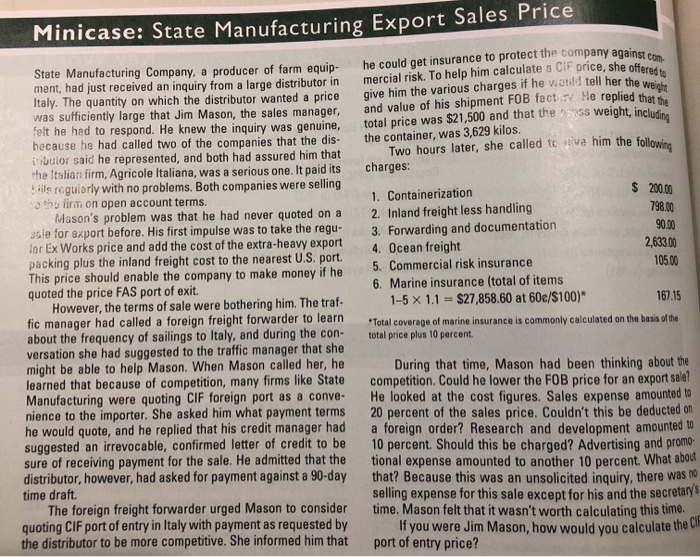Minicase: State Manufacturing Export Sales Price he could get insurance to protect the company against com mercial risk. To help him calculate a CiF price, she offered to give him the various charges if he v.atild tell her the weight State Manufacturing Company, a producer of farm equip- ment, had just received an inquiry from a large distributor in Italy. The quantity on which the distributor wanted a was sufficiently large that Jim Mason, the sales manager, felt he had to respond. He knew the inquiry was genuine, hecause he had called two of the companies that the dis- buior said he represented, and both had assured him that the Itslian firm, Agricole Italiana, was a serious one. It paid its ils rogularly with no problems. Both companies were selling thu firm on open account terms. Mason's problem was that he had never quoted on a ssle for export before. His first impulse was to take the regu- iar Ex Works price and add the cost of the extra-heavy export packing plus the inland freight cost to the nearest U.S. port. This price should enable the company to make money if he quoted the price FAS port of exit. However, the terms of sale were bothering him. The traf- fic manager had called a foreign freight forwarder to learn about the frequency of sailings to Italy, and during the con- versation she had suggested to the traffic manager that she might be able to help Mason. When Mason called her, he learned that because of competition, many firms like State Manufacturing were quoting CIF foreign port as a conve- nience to the importer. She asked him what payment terms he would quote, and he replied that his credit manager had suggested an irrevocable, confirmed letter of credit to be sure of receiving payment for the sale. He admitted that the distributor, however, had asked for payment against a 90-day time draft. The foreign freight forwarder urged Mason to consider quoting CIF port of entry in Italy with payment the distributor to be more competitive. She informed him that price and value of his shipment FOB fact He replied that the total price was $21,500 and that the ss weight, including the container, was 3,629 kilos. Two hours later, she called to ive him the following charges: $ 200.00 798.00 90.00 1. Containerization 2. Inland freight less handling 3. Forwarding and documentation 4. Ocean freight 5. Commercial risk insurance 6. Marine insurance (total of items 1-5 x 1.1 $27,858.60 at 60e/$100)* 2,63300 105.00 167.15 Total coverage of marine insurance is commonly calculated on the basis of the total price plus 10 percent During that time, Mason had been thinking about the competition. Could he lower the FOB price for an export sale? He looked at the cost figures. Sales expense amounted to 20 percent of the sales price. Couldn't this be deducted on a foreign order? Research and development amounted to 10 percent. Should this be charged? Advertising and promo tional expense amounted to another 10 percent. What about that? Because this was an unsolicited inquiry, there was no selling expense for this sale except for his and the secretarys time. Mason felt that it wasn't worth calculating this time. If you were Jim Mason, how would you calculate the lh port of entry price? requested by as Minicase: State Manufacturing Export Sales Price he could get insurance to protect the company against com mercial risk. To help him calculate a CiF price, she offered to give him the various charges if he v.atild tell her the weight State Manufacturing Company, a producer of farm equip- ment, had just received an inquiry from a large distributor in Italy. The quantity on which the distributor wanted a was sufficiently large that Jim Mason, the sales manager, felt he had to respond. He knew the inquiry was genuine, hecause he had called two of the companies that the dis- buior said he represented, and both had assured him that the Itslian firm, Agricole Italiana, was a serious one. It paid its ils rogularly with no problems. Both companies were selling thu firm on open account terms. Mason's problem was that he had never quoted on a ssle for export before. His first impulse was to take the regu- iar Ex Works price and add the cost of the extra-heavy export packing plus the inland freight cost to the nearest U.S. port. This price should enable the company to make money if he quoted the price FAS port of exit. However, the terms of sale were bothering him. The traf- fic manager had called a foreign freight forwarder to learn about the frequency of sailings to Italy, and during the con- versation she had suggested to the traffic manager that she might be able to help Mason. When Mason called her, he learned that because of competition, many firms like State Manufacturing were quoting CIF foreign port as a conve- nience to the importer. She asked him what payment terms he would quote, and he replied that his credit manager had suggested an irrevocable, confirmed letter of credit to be sure of receiving payment for the sale. He admitted that the distributor, however, had asked for payment against a 90-day time draft. The foreign freight forwarder urged Mason to consider quoting CIF port of entry in Italy with payment the distributor to be more competitive. She informed him that price and value of his shipment FOB fact He replied that the total price was $21,500 and that the ss weight, including the container, was 3,629 kilos. Two hours later, she called to ive him the following charges: $ 200.00 798.00 90.00 1. Containerization 2. Inland freight less handling 3. Forwarding and documentation 4. Ocean freight 5. Commercial risk insurance 6. Marine insurance (total of items 1-5 x 1.1 $27,858.60 at 60e/$100)* 2,63300 105.00 167.15 Total coverage of marine insurance is commonly calculated on the basis of the total price plus 10 percent During that time, Mason had been thinking about the competition. Could he lower the FOB price for an export sale? He looked at the cost figures. Sales expense amounted to 20 percent of the sales price. Couldn't this be deducted on a foreign order? Research and development amounted to 10 percent. Should this be charged? Advertising and promo tional expense amounted to another 10 percent. What about that? Because this was an unsolicited inquiry, there was no selling expense for this sale except for his and the secretarys time. Mason felt that it wasn't worth calculating this time. If you were Jim Mason, how would you calculate the lh port of entry price? requested by as







